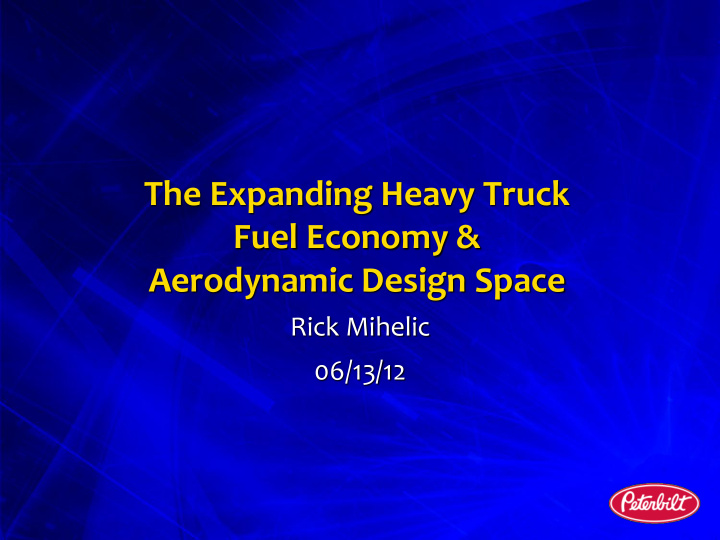



The Expanding Heavy Truck Fuel Economy & Aerodynamic Design Space Rick Mihelic 06/13/12
Where Are We? Potential Tractor-Only Aerodynamic Improvement Potential Time Technology S-Curve
Evolving World Late 1930's $0.10 / gal No Regulations 1990's - Mid 2000's $1.10 - $2.40 / gal 2002, 2007 EPA, ULSD Fuel 2012 $3.78 - $4.14 / gal EPA 2010, CARB/SmartWay, EPA/NHTSA GHG, ULSD Fuel
Change Drivers • Competition • Costs • Regulations • Technology
Continuous Improvement Model 281 Model 360 Model 351 Model 334 Model 359 Model 348 1939 1949 1954 1956 1967 Model 330 Model 385 Model 387 1970 1981 1986 1999 Model 1994 Model 386 1995 CB 200/300 Model 587 Model 362 2006 Model 379 2012 Model 579 2010
Latest Vehicles Model 587 Model 579
Innovation S-Curves Emerging Technology Potential Strategic Change Current Technology Time
Roof Fairing S-Curve Example >>Better High Drag 1970's-1980's Technology S-Curve Improved Performance Added Weight Added Cost Maintained Image
Where We Are Today Potential SmartWay Strategic Aero Tractors-Only Change SmartWay Aero-Tractor With SmartWay Device Equipped Trailer Time Technology S-Curves
Expanding Design Space Highway Levels • Part The Aerodynamic Design • Sub System • "Box" Must Expand To System • Tractor & Trailer Achieve Objectives • Multiple Vehicles • Multiple Vehicles & Highway
Regulatory Influence • EPA Engine Emissions Rules • EPA SmartWay • California EPA CARB/SmartWay • EPA/NHTSA GHG Emissions • FHWA Bridge Law • DOT Rules • Others
Operating Costs Driver Wages Tolls 27% 2% Driver Benefits Tires 9% 2% Permits & Licenses 2% Insurance Premiums Every Cost Matters 3% Fuel Is The Largest Repair & Variable Maintenance 7% Truck/Trailer Lease/Purchase Fuel & Oil Costs Payments 32% 16% Compiled From American Transportation Research Institute ATRI 2011 Update for 2008-2010
Fuel Price Forces 5 Diesel Price 4 Diesel Fuel Price Increases Spur $/Gal 3 Aero/MPG Design 2 1 ULSD From DOE Statistics 1938 Today
Freight Efficiency 0.045 Progress Has No Limits Gallons Per Ton and Per Mile 0.040 But Endless Trade-Offs 0.035 0.030 0.025 0.020 0.015 Continuously Improving 0.010 0.005 From FHWA Statistics 0.000 1975 1980 1985 1990 1995 2000 2005
Aerodynamic Drag 35%-40% Drag Reduction Drag Cd 2012 1998 1938 1990 Year Significant Tractor Drag Reduction
Improved Analysis 2002 Highway Levels • Part • Sub System • System • Tractor & Trailer Today • Multiple Vehicles • Multiple Vehicles & Highway
Energy vs. Speed HP HP Contribution Contribution 300 300 Aerodynamics Is A Factor 250 250 At All Speeds 200 200 150 150 100 100 50 50 0 0 20 30 40 50 60 70 80 Level Highway Speed MPH Aerodynamic Drag Rolling Friction and Accessories
Piece Part Approach
Piece Part Trailer Aero Device Focus SmartWay
Tractor/Trailer System Design "Five Manufacturers on Track to Meet SuperTruck Goals - 50% Freight Efficiency Gains " Transport Topics Headline 2/6/12
Trailing Distance FHWA states 3m truck spacing has 10-15% emissions reductions Multi-Vehicle Design Envelope 12% Fuel Saved 1% 0% 250' 100' 20' Trailing Distance Data from Peloton Technology
Infrastructure Design Envelope Truck-Only Lanes, Routing Feedback Systems, Vehicle • Potential Rule Changes Spacing, Multi-Trailer, Road/Rail • Length • Width Optimization, Distribution • Max Weight Systems • Max Axles • Long Combination Vehicles • Fuel Efficiency • Homologation • Emerging Technologies Source: California Department of Transportation, 2005
Design Space Next Steps Potential Today Future Add-On Part Multi-Vehicle Approach To Trailers With Interaction Optimized Aero Tractors & Interactive Infrastructure Strategic Tomorrow Change Total Tractor/Trailer System Time Technology S-Curves
Conclusion • The Size Of Self-Imposed Design Space Limits The Performance Potential • The Future Design Envelope Includes – Integrated Tractor/Trailer Designs – Multi-Vehicle Interactions – Highway Infrastructure Interaction – Rule Optimization
We know most of the answers; we need to apply them . Kevin R. Cooper 2002 UEF Conference on Truck and Bus Aerodynamics Commercial Vehicle Aerodynamic Drag Reduction: Historical Perspective as a Guide National Research Council of Canada
Recommend
More recommend